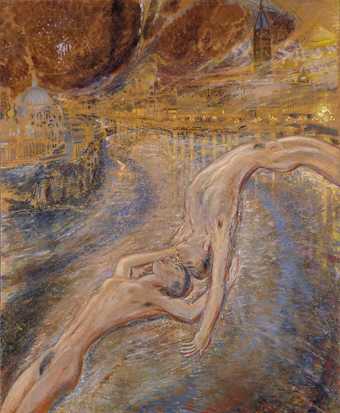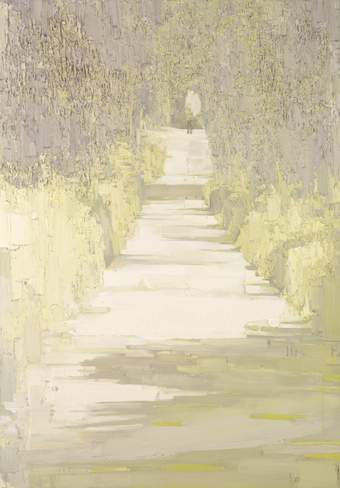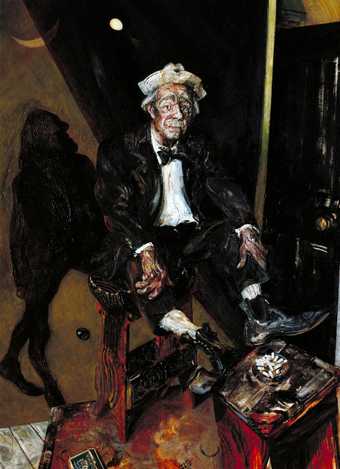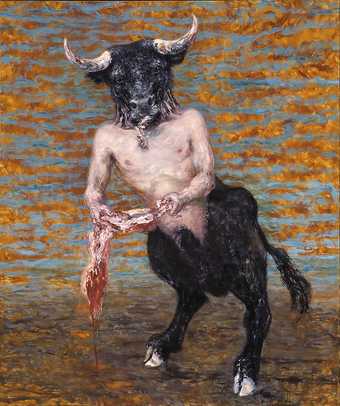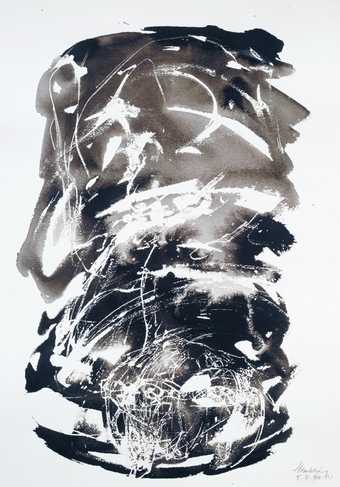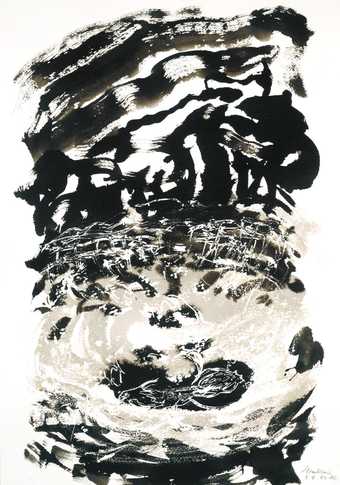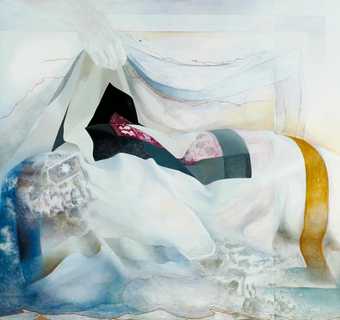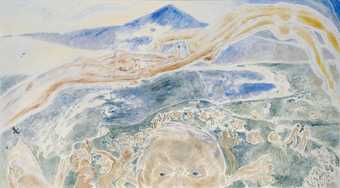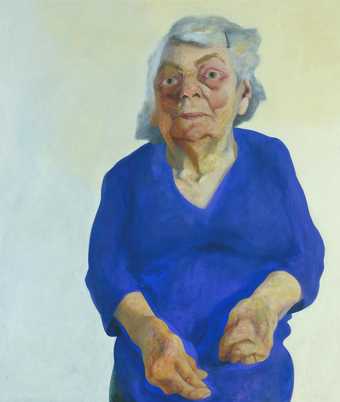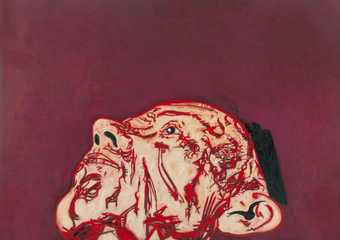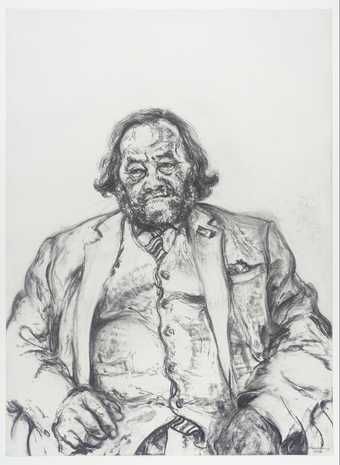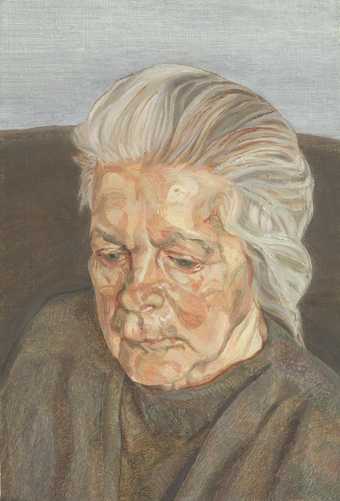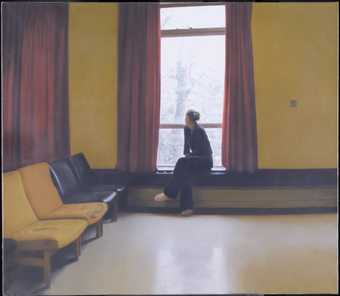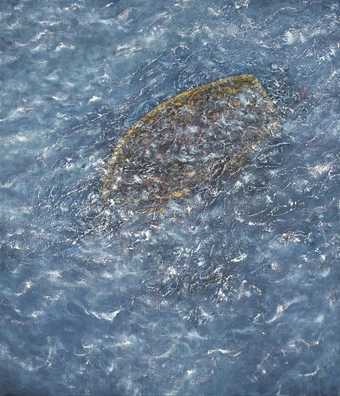
Not on display
- Artist
- Maggi Hambling born 1945
- Medium
- Oil paint on canvas
- Dimensions
- Support: 1703 × 1220 × 25 mm
- Collection
- Tate
- Acquisition
- Presented anonymously 2002
- Reference
- T07835
Summary
Hambling is best known for her intimate portraits of friends and family. One of her first exhibitions, held at the Morley Gallery, London SE1 in 1973, was of portraits drawn from memory and from observation. Her subject matter subsequently extended to allegorical paintings and sculpture and a number of near-abstract watercolours and drawings. Father, Late December 1997 is one from a series depicting the artist’s father, Henry Hambling (1902-98), recorded by his daughter during the last five years of his life. It was shown in an exhibition devoted to him, entitled Father, at Morley Gallery in 2001. The painting was initially titled Father, Christmas, but Hambling changed the title as she felt that it could easily be misinterpreted as portraying Santa Claus. A number of the works in the exhibition at the Morley Gallery marked a technical departure for Hambling in that she began to paint on board, although this particular work is on canvas. They are distinguished by a sketchy style of painting, closer to the characteristics of drawing than those usually associated with the application of paint. Hambling had recently begun to make sculptures by pouring strands of molten wax into sand and then casting the wax in bronze, creating a kind of three-dimensional drawing. Father 1994 (private collection) is a bronze sculpture depicting Henry Hambling’s head made in this manner. Hambling believes that this method of sculpting strongly influenced the style of painting she used for the portraits of her father.
Hambling’s first painting of her father dates from the early 1970s. Although she sketched him frequently over the following years, she didn’t paint him again until 1993. Henry Hambling took up painting at the age of sixty-five, painting the Suffolk countryside from observation until his death. Hambling drew him painting many times. She has commented:
Father didn’t ever set out to pose for me, for up to the end he was active and wanted to do things. So my sketchbook drawings tended to be of him watching television or of him at work when he started to paint. He had been very much in the background throughout my childhood. It was when he started to paint that we really became friends and began to move closer to each other ... Drawing my father was a way of beginning to know him, and I put my feelings about him into the drawings. When he began to paint I began to know him for the first time and recognized finally my love for him.
(Quoted in Father, p.9.)
The paintings and drawings of Henry Hambling show the passage of time, reflected in his gradually ageing image, his head sinking further and further into his chest until finally, in January 1998, he is depicted lying close to death. Father, Late December 1997 was painted from memory in Hambling’s studio. It portrays Henry Hambling sitting on a red patterned sofa, a favourite piece of furniture where, the artist has recounted, on returning to the house after being taken out on an expedition, ‘he ... just moved into that sofa, and established it as his territory and refuge. He would fall asleep with his head on his arm on the arm of the sofa, or talk sometimes to himself, or just sit there looking out at you.’ (Quoted in Father, p.12.) In his triple portrait, Henry Hambling’s upper body does all these things, supported and contained on either side of the canvas by the patterned arms of the sofa. He is depicted graphically in energetic black lines on the white canvas which convey a sense of trembling animation even where the subject is asleep. A large area of white above the three heads, roughly half the canvas, emphasises the febrile movement below. The painting was made quickly and conveys Henry Hambling’s vulnerability and fragility, as well as his continuing energy, in its urgent lines.
Hambling has referred to this painting as having a different sense of pictorial space from her other works, as if air flowed through and around the portrait, bringing it close to her sculptures. Following her father’s death, Hambling went on to make a number of works from memory over a period of weeks. These paintings are a record of a relationship, the artist’s process of coming to terms with death and loss and also, more generally, of the human spirit or human consciousness in the face of physical degeneration.
Further reading:
Father: Paintings and Drawings by Maggi Hambling, exhibition catalogue, Morley Gallery, London 2001, pp.11-12, reproduced p.23 in colour
Maggi Hambling: Paintings, Drawings and Watercolours, exhibition catalogue, Serpentine Gallery, London 1987
Dr Judith Collins and George Melly, Towards Laughter: Maggi Hambling, exhibition catalogue, Northern Centre for Contemporary Art, Sunderland 1993
Elizabeth Manchester
December 2005
Does this text contain inaccurate information or language that you feel we should improve or change? We would like to hear from you.
Explore
- people(22,072)
-
- actions: postures and motions(9,111)
-
- head in hand / hands(278)
- adults(20,120)
-
- man, old(373)
- body(4,878)
-
- head / face(2,497)
You might like
-
Jeffery Camp Rocket Over Venice
1986 -
Gillian Carnegie Voi
2004 -
Maggi Hambling Max Wall and his Image
1981 -
Maggi Hambling Minotaur Surprised while Eating
1986–7 -
Maggi Hambling Mud Dream 1
1990 -
Maggi Hambling Mud Dream 6
1990 -
Rita Donagh Counterpane
1987–8 -
Jeffery Camp Southcoast
1990 -
Maggi Hambling Portrait of Frances Rose
1973 -
Tony Bevan Head
1995 -
Maggi Hambling Portrait of Dr David Brown
1986 -
Lucian Freud The Painter’s Mother IV
1973 -
Gillian Carnegie rsXXII-/8-7
2007 -
Paul Winstanley Woman at a Window 2
2003 -
Maggi Hambling 2016
2016

